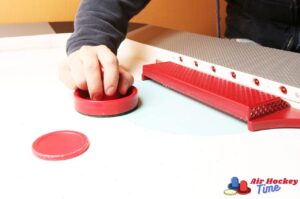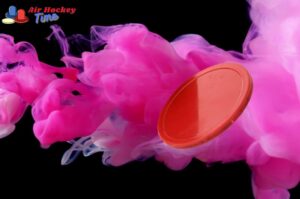Are you a newcomer to air hockey, or do you need some clarification about the rules? Have no fear- we have the answers!
In this blog post, we’re diving into one of the trickier questions in air hockey: Do self-goals count?
We know that playing any game can be daunting, and you want to do everything according to protocol.
Plus, when an element of competition is involved, who wants their team dishing out points without having them count!? The short answer is Yes– self-goals also count in air hockey.
However, there are some conditions and restrictions so it can get a bit complicated.
Please continue reading for advice on how to keep score properly with our expert tips!

The challenging rules of air hockey
Introducing the challenging rules of air hockey brings to light the intricacies and dynamics that make the game both exciting and demanding.
While the basic concept of hitting a puck into the opponent’s goal seems simple, the game’s rules add complexity.
Players must navigate the strict prohibition of using any part of their body to touch the puck, emphasizing the exclusive use of the mallet.
The game’s fast-paced nature requires quick reflexes and precise control, as players must avoid fouls such as “topping” or “palming” the puck.
Additionally, players must be mindful of not obstructing their opponent’s shot by blocking their line of sight or deliberately impeding their movements.
Mastering these challenging rules involves a combination of skill, strategy, and a deep understanding of the game’s nuances.
Players strive to balance offensive and defensive maneuvers with each match while adhering to the rulebook, creating an intense and engaging air hockey experience.
How do these types of self-goals occur?
In air hockey, self-goals occur when a player unintentionally scores a point by knocking the puck into their own goal without any deflection from the opposing player.
This situation typically arises when a player takes a shot and accidentally drops their mallet, allowing the puck to enter their own goal.
Interestingly, despite the unintended nature of the self-goal, the point still counts in favor of the opposing player.
What is the potential benefit of allowing self-goals to count
The potential benefit of allowing self-goals to count in air hockey lies in the fairness and integrity it brings to the game.
While self-goals may seem disadvantageous to the player committing them, counting them as valid points adds an element of accountability and encourage players to exercise greater caution and control.
It creates a level playing field where players must remain focused and mindful of their actions, enhancing the skill and strategy required to succeed.
Allowing self-goals to count also adds an element of excitement and unpredictability, as a momentary lapse in concentration can quickly turn the game’s tide.
By recognizing self-goals as valid points, air hockey maintains its competitive nature while promoting sportsmanship and continuously encouraging players to improve their technique and concentration.
How to prevent self-goals while playing air hockey?
Preventing self-goals while playing air hockey requires focus, control, and strategic positioning. Firstly, maintaining a firm grip on the mallet is crucial.
Pay attention to your hand placement and grip strength, ensuring a secure hold throughout the game.
Practice your shot execution and aim to minimize the chances of accidentally dropping the mallet during a shot. Additionally, be aware of your body positioning.
Maintain a balanced stance and avoid leaning too far forward or backward, as this can destabilize your control over the mallet and lead to unintended self-goals.
Stay focused on the puck, tracking its movements and anticipating rebounds or deflections.
Quick reflexes are essential to react promptly and prevent self-goals.
Lastly, strive for precision in your shots and defensive maneuvers.
Aim to direct the puck away from your goal using strategic angles and controlled force.
By implementing these strategies and maintaining a high concentration level, you can significantly reduce the occurrence of self-goals and enhance your performance in air hockey.
Frequently asked questions
What is “palming” in an air hockey game?
In an air hockey game, “palming” refers to a foul when any part of a player’s hand, arm, body, or clothing comes into contact with the puck.
Suppose a player’s hand or any other unauthorized body part touches the puck during gameplay. In that case, it is considered a violation and will be penalized with a “palming” call by the referee. This rule ensures fair and legitimate gameplay, where only the mallet can interact with the puck. The game maintains its fast-paced and skill-based nature by prohibiting players from using their hands or other body parts to control or manipulate the puck.
It relies solely on the players’ mallet-handling abilities and strategic decision-making.
Are there penalties in air hockey?
Certainly! In air hockey, penalties exist to ensure fair play and maintain the integrity of the game. There are two types of penalties.
Firstly, a foul results in the forfeiture of the puck.
When a player commits a foul, they lose possession of the puck, giving it to their opponent.
This penalty is a deterrent for rule violations, such as touching the puck with any part of the body or using unsportsmanlike conduct.
Secondly, a technical foul incurs a more severe penalty.
In the case of a technical foul, the innocent player is granted a free shot at the unprotected goal of the guilty player.
This penalty emphasizes the importance of following the rules and discourages actions that can significantly impact the game’s outcome.
By implementing penalties, air hockey promotes fair competition, sportsmanship, and adherence to the established guidelines of the game.
In conclusion
Self-goals do count in air hockey.
If a player inadvertently knocks the puck into their own goal without any deflection from the opposing player, the point is awarded to the opposing team.
While self-goals may seem disadvantageous, they add an element of fairness and challenge to the game.
This rule encourages players to maintain focus, exercise control, and be mindful of their actions on the table.
It highlights the importance of precision and strategic positioning to prevent self-goals from occurring.
Including self-goals in the scoring system adds excitement and unpredictability to air hockey matches, keeping players engaged and ensuring a competitive and balanced gameplay experience.
Ultimately, understanding and respecting the rule of self-goals contributes to the integrity and dynamics of air hockey as a thrilling and skill-driven sport.








